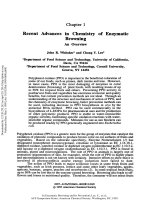2002 recent advances in larval recruitment processes of scyllarid and palinurid lobsters in japanese waters
Bạn đang xem bản rút gọn của tài liệu. Xem và tải ngay bản đầy đủ của tài liệu tại đây (884.86 KB, 11 trang )
Journal of Oceanography, Vol. 58, pp. 747 to 757, 2002
Review
Recent Advances in Larval Recruitment Processes of
Scyllarid and Palinurid Lobsters in Japanese Waters
H IDEO S EKIGUCHI* and NARIAKI INOUE
Faculty of Bioresources, Mie University, Kamihama-cho, Tsu, Mie 514-8507, Japan
(Received 16 January 2002; in revised form 14 March 2002; accepted 16 March 2002)
Phyllosoma larvae collected to date in Japanese and Taiwanese waters have been classified into two genera (Linuparus, Panulirus) of the Palinuridae, four genera (Ibacus,
Parribacus, Scyllarides, Scyllarus) of the Scyllaridae, and one genus (Palinurellus) of
the Synaxidae. However, phyllosoma larvae of three Scyllarus species (S. bicuspidatus,
S. cultrifer, S. kitanoviriosus) are absolutely dominant among the larvae collected in
the waters. Scyllarus larvae are abundant in coastal waters while those of Panulirus
are often collected in offshore/oceanic waters. Based on previous and ongoing studies
dealing with spatial distributions of phyllosoma larvae in Japanese and Taiwanese
waters, it appears that phyllosoma and nisto larvae of the Scyllarus are retained within
coastal waters north of the Kuroshio Current. On the other hand, the life history of
the Panulirus (particularly P. japonicus) may be completed within the Kuroshio
Subgyre: their phyllosoma larvae may be flushed out from coastal waters into the
Kuroshio, then transported through the Counter Current south of the Kuroshio into
the water east of Ryukyu Archipelago and Taiwan where they attain the subfinal/
final phyllosoma or puerulus stages, once again entering the Kuroshio and dispersing
into coastal waters.
Keywords:
⋅ Larval recruitment,
⋅ phyllosoma,
⋅ puerulus,
⋅ nisto,
⋅ Panulirus
japonicus.
Compared to a variety of studies dealing with larval
recruitment processes of two palinurid lobsters, the western Australian rock lobster Panulirus cygnus and New
Zealand red rock lobster Jasus edwardsii (see Booth and
Phillips, 1994), little information had accumulated on the
early life history of P. japonicus, the predominant
palinurid in Japanese waters, before 1985, when Sekiguchi
(1985) advanced a hypothesis to explain the recruitment
process of the species by putting together fragmentary
information on its early life history and taking into account water circulation within the Kuroshio Subgyre.
Twelve years latter, Sekiguchi (1997) examined and/or
tested his hypothesis using evidence that had become
available until 1997. Sekiguchi’s (1985, 1997) hypothesis was thereafter supported by direct evidence obtained
by Yoshimura et al. (1999) and Inoue and Sekiguchi
(2001).
Our goal is to clarify the larval recruitment processes
by which P. japonicus populations are maintained in Japanese waters. To do this, we must address several essential issues, e.g. (1) estimating the abundance and stock
size of scyllarid and palinurid lobsters, (2) identifying
phyllosoma and puerulus/nisto larvae, (3) examining the
1. Introduction
Lobsters belonging to three families (Palinuridae,
Scyllaridae, Synaxidae) pass through three phases of life
in their ontogeny: planktonic life for phyllosoma larvae,
a transition from planktonic to benthic life for puerulus/
nisto larvae, and benthic life for juveniles and adults. The
phyllosoma is the long-lived, leaf-like, transparent, planktonic zoea that is thought to be a poor horizontal swimmer but a strong vertical one. The phyllosoma period usually lasts for at least several months for most scyllarid
lobsters while it is nine months and more (twenty-two
months in Jasus edwardsii) for most palinurid lobsters,
with the result that palinurid larvae can disperse over a
long distance from coastal to offshore/oceanic waters
(Booth and Phillips, 1994; Cobb, 1997). Moreover, the
puerulus is a short-lived megalopa, a strong horizontal
swimmer, which is a transitional stage between planktonic phyllosoma larvae and benthic juveniles (Booth and
Phillips, 1994).
* Corresponding author. E-mail:
Copyright © The Oceanographic Society of Japan.
747
spatial distribution of the species composition and abundance of the larvae as related with their behavior and ecology, (4) advancing hypotheses to explain the larval recruitment processes of the Scyllarus and the Panulirus,
particularly P. japonicus, (5) examining spatial and temporal variations in larval settlement and recruitment of
the lobsters, (6) understanding relationships between larval recruitment strength and stock size of the lobsters,
and so on. In this review, we deal mainly with the first
four issues, larval recruitment processes of Scyllarus and
Panulirus spp., particularly P. japonicus. Issues (5) and
(6) will be dealt with in a forthcoming paper.
2.
Scyllarid and Palinurid Adult Lobsters with a
Note on Geographical Distributions of Panulirus
Species
Marine fauna in Japanese and Taiwanese waters share
a wide variety of species because Ryukyu Archipelago,
southern Japan, and Taiwan belong to the subtropical/
tropical region in biogeographical terms, and are exposed
to the powerful influence of the Kuroshio Current, flowing along the coasts of the Archipelago and Taiwan (Fig.
1). A total of 39 adult species (31 and 33 species in Japanese and Taiwanese waters, respectively) have been reported to date (Table 1). They belong to five genera
(Justitia, Linuparus, Palinustus, Panulirus, Puerulus) of
the Palinuridae, six genera (Arctides, Ibacus, Parribacus,
Scyllarides, Scyllarus, Thenus) of the Scyllaridae, and one
genus (Palinurellus) of the Synaxidae. However,
Panulirus species are absolutely dominant among the
palinurid lobsters and are also commercially important
to Japan and Taiwan, particularly P. japonicus in Japan
and three species (P. japonicus, P. longipes s. l., P.
stimpsoni) in Taiwan (Ho and Yu, 1987; Huang et al.,
1988; Sekiguchi, 1988a). Total annual catch yields of
palinurids over the last two decades have been ca. 1000
tons and 200–300 tons in Japan and Taiwan, respectively.
Scyllarus species may be abundant and dominant among
scyllarid lobsters, which has been supported by abundance
data on phyllosoma larvae in Japanese and Taiwanese
waters (Sekiguchi, 1988a, b; Inoue et al., 2000, 2001).
However, scyllarids are not important commercially to
Japan or Taiwan, although Ibacus and Scyllarides species are consumed locally.
Until 1996, two subspecies of the commercially important Indo-West Pacific spiny lobster Panulirus longipes
were recognized (Holthuis, 1991): the western spottedlegged form P. longipes longipes and the eastern stripedlegged form P. longipes femoristriga. Chan and Chu
(1996) discussed the taxonomy of P. longipes s. l. and
Fig. 1. Current systems in the upper layer of Japanese and its neighboring waters (from Kawai, 1991), with notes on geographical
distributions of Panulirus japonicus and P. longipes bispinosus (from Sekiguchi, 1988a). A, warm Kuroshio Current;
A′, Kuroshio-Counter Current; B, B′, B″, branches of the Kuroshio; C, cool Oyashio Current; D, warm Tsugaru Current;
E, warm Soya Current; F, warm Tsushima Current. Areas with horizontal and vertical lines indicate geographical distributions
of P. japonicus and P. longipes bispinosus, respectively.
748
H. Sekiguchi and N. Inoue
described a new species, P. albiflagella, which they believed had previously been misidentified as P. longipes
femoristriga. Chan and Chu (1996) also argued that P.
longipes bispinosus was a junior subjective synonym of
P. longipes femoristriga. Based on the morphological features of P. longipes femoristriga specimens collected in
Japanese waters, including the Ogasawara Islands, and
also on the color patterns of their antennular flagella,
Sekiguchi (1991) divided these specimens into three
types: “Aka-ebi”, “Shirahige-ebi” and “Shironuke-ebi”.
Of these types, “Shirahige-ebi” and “Shironuke-ebi” are
identical to P. longipes bispinosus (=P. longipes
femoristriga) and P. femoristriga (P. albiflagella), respec-
tively, according to Chan and Ng (2001) who examined
the nomenclature of the three species (P. longipes
femoristriga, P. longipes bispinosus, P. albiflagella).
Thus, we believe another new Panulirus species name
will be given to “Aka-ebi” in the Ogasawara Islands
(George and Sekiguchi, pers. comm.).
P. japonicus is confined to Japanese and Taiwanese
waters (Fig. 1), though it is abundant in northern Taiwanese waters while it is meager in number in Cheju Island,
southern Korea (Sekiguchi, 1997). But the species has
not been reported from Ogasawara and Iou Islands, from
Ryukyu Archipelago where P. longipes bispinosus replaces it, and from the central to southern parts of Tai-
Table 1. List of lobster species belonging to the three families (Palinuridae, Scyllaridae and Synaxidae) reported to date in
Japanese and Taiwanese waters.
Palinuridae
1
2
3
4
5
Justitia
J. chani +*
J. japonica +*
J. longimanus +*
Linuparus
L. sordidus*
L. trigonus +*
6
7
8
Palinustus
Pa. unicornutus +*
Pa. holthuisi +*
Pa. waguensis +
9
10
11
12
13
14
15
16
17
18
Panulirus
P. japonicus +*
P. longipes bispinosus +*
P. longipes longipes +*
P. femoristriga +*
P. homarus homarus +*
P. ornatus +*
P. penicillatus +*
P. polyphagus*
P. stimpsoni*
P. versicolor +*
19
Puerulus
Pu. angulatus +*
Scyllaridae
20
Arctides
A. regalis +
21
22
Ibacus
I. ciliatus +*
I. norvemdentatus +*
23
24
Parribacus
Par. antarcticus +*
Par. japonicus*
25
26
Scyllarides
Sc. haanii +*
Sc. squamosus +*
27
28
29
30
31
32
33
34
35
36
37
Scyllarus
S. aurora +
S. bicuspidatus +
S. batei*
S. bertholdii*
S. brevicornis +*
S. cultrifer +*
S. formosanus*
S. kitanoviriosus +*
S. longidactylus +*
S. martensii +*
S. rugosus +*
38
Thenus
T. orientalis +*
Synaxidae
39
Palinurellus
Pal. wieneckii +
This list is based on Chan and Yu (1986, 1992, 1995), Sekiguchi (1986b), Poupin (1994), Nomura and Sekiguchi (1995),
Chan and Chu (1996), Nomura (1998) and Chan and Ng (2001).
Symbols + and * indicate the species reported from Japanese and Taiwanese waters, respectively.
Larval Recruitment of Scyllarid and Palinurid Lobsters
749
wan, where it is replaced by P. homarus homarus. However, both P. japonicus and P. longipes bispinosus have
been reported to occur together in Amami-oshima,
Tanegashima and Yakushima Islands, and in northern
Taiwan (Huang et al., 1988; Sekiguchi, 1988a, 1988b,
1989). None of P. longipes bispinosus nor P. japonicus
occur on the coasts of the mainland China and Russia
along the East China, Yellow and Japan Seas, because
they can not survive the severe winter (Sekiguchi, 1988a,
b). In summary, the geographical distribution of P.
japonicus is confined to coastal waters north of the
Kuroshio Current. What determines this geographical distribution of P. japonicus remains unclear. According to
recent studies by Sekiguchi (1988a, 1989, 1995), it is
probable that the presence of either coral or rocky reefs
determines the presence of P. longipes bispinosus and P.
japonicus, respectively. Coral reefs are common and are
developing in the Ryukyu Archipelago, but in Taiwan they
are confined to its southern tip. The northern boundary
of coral reefs in Japanese (and neighboring) waters is the
Tokara Strait between Amami-oshima and Yakushima Islands, the eastern boundary lying between Torishima and
Ogasawara Islands (Takahashi, 1988). Since P. japonicus
has been found in waters without coral reefs but with
rocky reefs, it is assumed that the southern boundary of
the P. japonicus distribution coincides with the northern
boundary of the coral reef distribution in the western
North Pacific and also with the northern boundary of the
Kuroshio Current (Sekiguchi, 1989). According to De
Bruin (1962) and George (1967, 1974), the two subspecies of P. longipes are typical inhabitants of coral reef
waters, though they prefer the waters outside of coral areas. This is also true of P. longipes bispinosus in the
Ryukyu (Shokita et al., 1984). On the other hand, P.
japonicus typically inhabits rocky reefs directly exposed
to the ocean (Sekiguchi, 1989).
3.
Identification of Phyllosoma and Puerulus/Nisto
Larvae
3.1 Phyllosoma larvae
Phyllosoma larvae collected to date in Japanese and
Taiwanese waters have been classified into three genera
(Linuparus, Panulirus, Puerulus) of the Palinuridae, four
genera (Ibacus, Parribacus, Scyllarides, Scyllarus) of the
Scyllaridae, and one genus (Palinurellus) of the Synaxidae
(Sekiguchi, 1986a, b; Sekiguchi and Saisho, 1994; Inoue
et al., 2000, 2001; Inoue and Sekiguchi, 2001). However,
phyllosoma larvae of three Scyllarus species are absolutely dominant among the larvae collected in the waters
(Sekiguchi, 1986a, b; Inoue et al., 2000, 2001): S.
bicuspidatus, S. cultrifer and S. kitanoviriosus, the last
of which is dominant in Taiwanese waters. Scyllarus
phyllosoma are abundant in coastal waters, whereas
750
H. Sekiguchi and N. Inoue
Panulirus ones are often collected in offshore/oceanic
waters (Inoue et al., 2000, 2001; Inoue and Sekiguchi,
2001). Based on previous studies, identification keys for
phyllosoma larvae of the Scyllarus and the Panulirus are
compiled in Tables 2 and 3.
Based on specimens of late-stage phyllosoma larvae
of the Panulirus collected in Japanese waters, Murano
(1971) classified these specimens into five types (Forms
A–E) and tentatively identified his Form A and further
Form F described by Oshima (1942) as P. japonicus. This
identification was supported by Sekiguchi (1986b), and
also by Inoue (1981) who succeeded in rearing eggs and
in growing phyllosoma to the final stage phyllosoma in
laboratory, deducing from Forms A and F, which have
width ratios of the cephalon to the thorax similar to those
of P. japonicus phyllosoma larvae reared in laboratory.
However, since the width ratios of P. longipes s. l. (P.
longipes bispinosus and P. femoristriga in this case) overlap those of P. japonicus, it may be difficult to distinguish phyllosoma larvae of P. japonicus from the above
two species using the width ratios and the other morphological features (Table 3; Yoshimura et al., 1999; Inoue
and Sekiguchi, 2001). Thus, as indicated by Yoshimura
et al. (1999) and Inoue and Sekiguchi (2001), we can identify phyllosoma larvae of P. japonicus in Japanese and
Taiwanese waters based on the following facts: the final
stage phyllosoma larvae of P. longipes s. l. develop into
the puerulus in October and later while those of P.
japonicus do mainly in summer, and that the puerulus of
the former, settles in October to April, while those of the
latter, in summer.
3.2 Puerulus/nisto larvae
As referred to in Table 1, six Panulirus species are
found in Japanese waters: P. homarus homarus, P.
japonicus, P. longipes s. l., P. ornatus, P. penicillatus and
P. versicolor, of which P. japonicus is absolutely dominant, though P. longipes bispinosus is found commonly
in Ryukyu Archipelago while “Aka-ebi” is found in the
Ogasawara Islands where the other four Panulirus species except P. japonicus are reported as well as in the
Ryukyu (Sekiguchi, 1991). Another Panulirus species (P.
stimpsoni and P. polyphagus) are reported from Taiwan
(Table 1).
P. japonicus and P. longipes s. l. are regarded as sibling species to be classified as belonging to the P.
japonicus group (P. cygnus, P. japonicus, P. longipes s.
l., P. marginatus, P. pascuensis) (George and Holthuis,
1965; George and Main, 1967). This indicates that it is
difficult to distinguish larvae of P. japonicus from those
of P. longipes s. l. However, we feel there is no problem
in distinguishing pueruli of P. japonicus from those of P.
longipes s. l. based on their morphological features
(Tanaka et al., 1984; Tanaka, 1987; Inoue et al., 2002),
Table 2. Identification key for the late-stage Scyllarus phyllosoma larvae collected in Japanese and Taiwanese waters.
1
Cephalic shield more or less trapezoidal in shape
Cephalic shield oval or round
(2)
(3)
2
Distal end of uropod pointed
Distal end of uropod not pointed
S. martensii
S. aurora
3
Telson extending beyond uropod, with two prominent posteriorly
directed lateral spines projecting beyond uropod
Telson not extending beyond uropod
(4)
(6)
4
Lateral process of antenna directed anteriorly
Lateral process of antenna directed laterally
S. bicuspidatus* 1
(5)
5
5th pereopod with coxal spine on the basal segment
5th pereopod without coxal spine on the basal segment
Scyllarus sp. d* 2
S. cultrifer* 3
6
Eyestalk longer than antennule; lateral process of antenna directed anteriorly
Eyestalk much shorter than antennule; lateral process of antenna directed laterally
Eyestalk nearly equal length to or shorter than antennule
S. kitanoviriosus
Scyllarus sp. e* 2
(7)
7
Lateral process of antenna directed laterally
Lateral process of antenna directed anteriorly
S. rugosus
Scyllarus sp. c* 4
This table was compiled based on Sekiguchi (1986b), Inoue et al. (2000, 2001) and Inoue and Sekiguchi (2001). Identification key for scyllarid genera has been compiled in Sekiguchi (1986b).
* 1S. bicuspidatus is identical with Scyllarus sp. a reported by Sekiguchi (1986b)’s key and also with S. bicuspidatus by
Inoue et al. (2000, 2001).
* 2Scyllarus sp. d and sp. e are reported from Taiwanese waters by Inoue et al. (2001).
* 3S. cultrifer is identical with S. bicuspidatus reported by Sekiguchi (1986b) that identified phyllosoma larvae according to
the identification key devised by Phillips et al. (1981) for the larvae collected in western Australian waters, and also with S.
cultrifer by Inoue et al. (2000, 2001).
* 4According to Sekiguchi (1986b)’s key, Scyllarus sp. c was identified with S. cultrifer. But Inoue et al. (2000) made clear
that these larvae were identified erroneously as S. cultrifer.
though it is difficult to distinguish between phyllosoma
larvae of the above two species as mentioned above (see
Inoue and Sekiguchi, 2001). Of the above six Panulirus
species in Japanese waters, morphological features of
pueruli of four species (P. homarus homarus, P. japonicus,
P. longipes s. l., P. penicillatus) were compiled for identification by Tanaka et al. (1984) and Tanaka (1987). Although P. japonicus pueruli are dominant among
Panulirus pueruli collected in Japanese waters (Ichiki et
al., 1976; Kanamori, 1982; Tanaka et al., 1984; Tanaka,
1987), pueruli of the other five Panulirus species are also
infrequently collected in coastal waters along the Pacific
coast of southern and central parts of Japan, because they
may be transported over a long distance through the
Kuroshio Current along Ryukyu Archipelago and Taiwan.
Unfortunately, it is difficult to specifically identify
Scyllarus nisto larvae in Japanese waters because information on their morphology is unavailable.
4.
Hypotheses to Explain Larval Recruitment Processes of Panulirus and Scyllarus Species, with Particular Reference to P. japonicus
4.1 Current systems in the upper layer
Coastal to offshore/oceanic processes affect larval
recruitment processes, i.e. long-distance dispersal and
transport of the long-lived phyllosoma larvae and also
the return of the late-stage phyllosoma and puerulus/nisto
larvae to coastal waters (Phillips, 1986; Cobb, 1997). As
a background to recruitment processes of Scyllarus and
Panulirus species in Japanese and Taiwanese waters, we
describe current systems in the upper layer of the western North Pacific.
Current systems in the upper layer of Japanese and
Taiwanese waters are illustrated in Fig. 1. The Kuroshio
Current located east of Taiwan enters the East China Sea
after passing through the strait between northern Taiwan
Larval Recruitment of Scyllarid and Palinurid Lobsters
751
Table 3. Identification key for the late-stage Panulirus phyllosoma larvae collected in Japanese waters.
1
2
3
Cephalic shield slightly or distinctly narrow than thorax,
coxal and subexopodal spines absent on pereopods
P. japonicus
P. longipes s. l.* 1
Cephalic shield nearly as wide as thorax or slightly narrow than thorax
(2)
Subexopodal spines absent on pereopods,
cephalic shield less oblong than in the above 2 species
P. penicillatus
Subexopodal spines present on pereopods
(3)
Coxal spines present on 3rd maxilliped and 1st to 4th pereopods,
though 3rd maxilliped and 1st pereopod with only ventral coxal spines
P. versicolor
Coxal spines present on 3rd maxilliped and 3rd pereopod,
though ventral coxal spines only on 3rd maxilliped.
Subexopodal spines present on 1st to 3rd pereopods
P. ornatus* 2
Dorsal coxal spines present on 2rd to 4th pereopods,
while ventral coxal spines on 3rd maxilliped and 1st pereopod
P. homarus* 3
This table was modified in part from Sekiguchi (1986b). According to Inoue and Sekiguchi (2001), two Panulirus species
(P. japonicus and P. longipes s. l.) are difficult to distinguish from each other. See text for further explanation. Identification key
for palinurid genera, including the Palinurellus, has been compiled in Sekiguchi (1986b).
*1To include the following four species: P. longipes longipes from Taiwan, P. longipes bispinosus and “Aka-ebi” from
Japan, and P. femoristriga from Japan and Taiwan. See text for further explanation.
*2In the gill/final stage, the 4th pereopod bears coxal spines.
*3In the gill/final stage, coxal spines are present on 2nd to 4th pereopods, but ventral spines are absent.
Fig. 2. Long-term geopotential anomaly at the sea-surface relative to the 1000-db surface in dynamic meters (10j kg–1)
(from Hasunuma and Yoshida, 1978).
752
H. Sekiguchi and N. Inoue
and the southern parts of the Ryukyu Archipelago. After
flowing along the continental shelf edge of the Sea and
then separating off the Tsushima Current that flows in
the water west of Kyushu and passes through Tsushima
Strait between Japan and Korea to enter the Japan Sea,
the Kuroshio Current passes through Tokara Strait between Amami-oshima and Yakushima Islands and flows
along the Pacific coast of the southern and central parts
of Japan.
Recent oceanographic studies indicate that the North
Pacific Subtropical Gyre is composed of three subgyres
(Fig. 2): from north to south, the Kuroshio-Counter Current Subgyre (=Kuroshio Subgyre), the Subtropical Current Subgyre and the North Tropical Current Subgyre.
Thus, the Counter Current that is joined to the Kuroshio
Current may consist mostly of the Kuroshio water, i.e.
forming the Kuroshio Subgyre (Hasunuma and Yoshida,
1978). These features are supported by recent studies using satellite-tracking buoys (Fig. 3; Ishii et al., 1982;
McNally et al., 1983; Michida and Ishii, 1993) and also
sea surface height anomaly data acquired by TOPEX/
POSEIDON and ERS altimeters (Ebuchi and Hanawa,
2001; Ichikawa, 2001).
Fig. 3. Trajectories of nine buoys in the period from 14 January 1980 to 15 May 1981 (from Ishii et al., 1982). Buoys were
deployed at the main Kuroshio west of Okinawa Islands, southern Japan. Numericals indicate the position at the first day of
each month.
The Ryukyu Archipelago is located east of the
Kuroshio Current, while the Ogasawara Islands lie south
of the Counter Current. According to Ishii (1981) who
examined trajectories of satellite-tracking buoys released
across the main axis of the Kuroshio, an anti-clockwise
mid-scale eddy has been detected in the water east of
Okinawa Islands where a buoy was retained for nearly
six months (see Sekiguchi, 1997). As referred to in Nitani
(1972) and Worthington and Kawai (1972), recent studies indicate that a northward or northeastward current
passes south and east of the Ryukyu Archipelago to coalesce with the main Kuroshio current passing through
Tokara Strait (Ichikawa and Beardsley, 1993; Liu et al.,
1998; Yuan et al., 1998). There are three branches of the
Kuroshio east of Taiwan (Yuan et al., 1998): the Kuroshio
in the East China Sea comes from the main (1st) and 2nd
branches of the Kuroshio east of Taiwan, and the easternmost (3rd) branch of the Kuroshio flows to the northeast
in the water south and east of the Ryukyu Archipelago.
Considerable westward or northwestward propagating
eddies are then found in the water east of Taiwan, indicating leakage of the Kuroshio water to the southeast/
east of Ryukyu Archipelago (Yang et al., 1999; Fig. 4).
4.2 Larval recruitment processes
According to the review by Booth and Phillips
(1994), the early life history of spiny lobsters can be summarized as follows: phyllosoma larvae appear to be poor
horizontal swimmers but swim more strongly vertically.
After early-stage phyllosoma larvae are flushed out from
coastal waters into offshore/oceanic waters, where they
Fig. 4. Trajectories of the WOCE/TOGA drifting buoys near
Taiwan in 1993 (from Yang et al., 1999).
develop for many months, some phyllosoma larvae return towards the continental shelf edge where they develop into the puerulus stage. Puerulus larvae are
megalopic, transitional between planktonic phyllosoma
larvae and benthic juveniles, and complete the oceanic
phase as a stronger swimmer. This is also true of scyllarid
phyllosoma larvae, except that their early life history is
completed within coastal waters due to a shorter larval
periods as compared to that of palinurid lobsters and also
to their larval strategies, which differ from those of
palinurid ones (Phillips et al., 1981; Sekiguchi, 1986a;
Baisre, 1994; Inoue et al., 2000, 2001).
Larval Recruitment of Scyllarid and Palinurid Lobsters
753
Fig. 5. Distribution of subfinal/final stage phyllosoma of Panulirus japonicus in the waters south of the Kuroshio Current and
east of the Ryukyu and Taiwan (from Inoue and Sekiguchi, 2001). Solid circles: sampling stations, numericals with solid
squares and open triangles: individual number of the final and subfinal stage phyllosoma larvae of P. japonicus, respectively,
numericals with open circles: individual number of P. penicillatus, dotted lines: isopleths of 200 m depth.
In relation to coastal to offshore/oceanic processes,
some behavioral traits of phyllosoma larvae, such as a
long larval period, different vertical distribution and migration related to developmental stage and so on, may
affect the dispersal and transport of the larvae. Scyllarus
phyllosoma larvae have a shorter larval period of several
months while Panulirus have a larval period of nine
months and more (Booth and Phillips, 1994). Based on
previous studies dealing with the vertical distribution and
migration of phyllosoma larvae, movements appear to be
confined to nocturnal vertical migration, focused in the
upper 150 m (Phillips et al., 1981; Yeung and McGowan,
1991; Booth, 1994; Minami et al., 2001). Patterns of vertical distribution and nocturnal vertical migration are very
similar between phyllosoma larvae of the Scyllarus and
the Panulirus (Yeung and McGowan, 1991; Minami et
al., 2001). However, Rimmer and Phillips (1979) and
Phillips et al. (1981) have stated that differences in the
vertical behavior of the larvae exist between the above
two genera.
Before Yoshimura et al. (1999) and Inoue and
Sekiguchi (2001), there was little information on the early
life history of P. japonicus in Japanese waters. It can be
summarized as follows (Sekiguchi, 1997): (1) the period
for phyllosoma larvae is nearly nine months according to
754
H. Sekiguchi and N. Inoue
culture experiments (Kittaka and Kimura, 1989;
Yamakawa et al., 1989), (2) first stage phyllosoma larvae, released in summer, have been collected in Japanese
coastal waters where berried females have been found
(Harada, 1957; Murano, 1967), (3) benthic populations
exist in waters exposed to the powerful influence of the
Kuroshio Current and its branches (Sekiguchi, 1985,
1997), (4) phyllosoma larvae in middle to late-stages have
rarely been collected in Japanese coastal waters north of
the Kuroshio (Sekiguchi, 1985, 1997), and (5) pueruli
settle in Japanese coastal waters commonly and abundantly in summer (Ichiki et al., 1976; Fushimi, 1978;
Kanamori, 1982). More recently, it was shown that latestages phyllosoma larvae are found mainly in waters south
of Kyushu and also east of the Ryukyu Archipelago, southern Japan (Yoshimura et al., 1999; Inoue and Sekiguchi,
2001). Putting together the fragmentary information on
the early life history of P. japonicus as related to water
circulation of the Kuroshio Subgyre, Sekiguchi (1985,
1997) advanced a hypothesis to explain the larval recruitment processes that maintain P. japonicus populations in
Japanese waters. Subsequently, Sekiguchi’s hypothesis
was supported by direct evidence of Yoshimura et al.
(1999) and Inoue and Sekiguchi (2001) as shown in Fig.
5.
Fig. 6. Early life history of Panulirus japonicus within the Kuroshio Subgyre as related to its larval recruitment. a, early stages
phyllosoma; b, middle to late stages phyllosoma; c, subfinal/final stage phyllosoma; d, puerulus. Areas with vertical lines
indicate the geographical distribution of P. japonicus. This illustration is based on Sekiguchi (1985, 1997) and Inoue and
Sekiguchi (2001). See text for further explanation.
Therefore, based on previous and ongoing studies
dealing with spatial distributions of phyllosoma larvae in
Japanese and Taiwanese waters, it is safe to say that
phyllosoma and nisto larvae of the Scyllarus may be retained within coastal waters west and north of the
Kuroshio Current (Sekiguchi, 1985, 1986a; Inoue et al.,
2000, 2001; Inoue and Sekiguchi, 2001). Scyllarus
phyllosoma are usually abundant in coastal waters while
Panulirus ones are often found in offshore/oceanic waters (Phillips et al., 1981; Baisre, 1994; Chiswell and
Booth, 1999). On the other hand, as Sekiguchi (1985,
1997) and Inoue and Sekiguchi (2001) have indicated
(Fig. 6), the life history of the Panulirus, particularly P.
japonicus, may be completed within the Kuroshio Subgyre
east and south Japanese Islands and also east of Taiwan,
so that it takes nearly one year from egg hatching to settlement: their phyllosoma larvae may be flushed out from
coastal waters into the Kuroshio, be transported through
the Kuroshio-Counter Current south of the Kuroshio into
the water east of the Ryukyu Archipelago and Taiwan
where they may attain the subfinal/final phyllosoma and
puerulus stages, again entering the Kuroshio to then disperse into the coastal waters. Thus, individuals of P.
japonicus in both Japanese and Taiwanese waters may
belong to the same population that is sustained by a common pool of the larvae, as suggested by Sekiguchi (1985,
1997) and Inoue et al. (2001).
Based on the notion that Sekiguchi’s hypothesis explaining larval recruitment of P. japonicus may be supported, the following three issues have to be explained in
the near feature: (1) mechanisms by which early-stage
phyllosoma larvae may be transported/flushed out into
the Kuroshio from the coastal waters north of the
Kuroshio, (2) mechanisms by which middle-stage
phyllosoma larvae may transfer from the Kuroshio to the
Counter Current, and mechanisms by which the final
(subfinal) phyllosoma or pueruli may enter the Kuroshio
from the waters east of Okinawa Islands and Taiwan.
Unfortunately, we have no information on issues (2) and
(3). However, we have some information concerning issue (1), i.e. Panulirus phyllosoma larvae are transported
into the Kuroshio while Scyllarus ones are retained within
the coastal waters north of the Kuroshio (Inoue et al.,
2000, 2001), as related to the difference between larval
periods of those two genera and also with no difference
between the vertical distribution of these two genera
(Minami et al., 2001). Sekiguchi (1997) have predicted
that most early-stage phyllosoma larvae of P. japonicus
may be collected in the Kuroshio region around
Hachijojima Island and neighboring waters east of the
Island, so we may have a good chance to make clear the
mechanisms by which the early-stage phyllosoma larvae
are transported into Kuroshio from the coastal waters.
Larval Recruitment of Scyllarid and Palinurid Lobsters
755
Acknowledgements
We wish to express our sincere thanks to Drs. J. D.
Booth and B. F. Phillips for their comments on the first
version of our manuscript.
References
Baisre, J. A. (1994): Phyllosoma larvae and the phylogeny of
Palinuridea (Crustacea: Decapoda): a review. Aust. J. Mar.
Freshwat. Res., 45, 925–944.
Booth, J. D. (1994): Jasus edwardsii larval recruitment off the
east coast of New Zealand. Crustaceana, 66, 295–317.
Booth, J. D. and B. F. Phillips (1994): Early life history of spiny
lobster. Crustaceana, 66, 271–294.
Chan, T. Y. and K. H. Chu (1996): On the different forms of
Panulirus longipes femoristriga (Von Martens, 1872)
(Crustaceana: Decapoda: Palinuridae), with description of
a new species. J. Nat. Hist., 30, 367–387.
Chan, T. Y. and P. K. L. Ng (2001): On the nomenclature of the
commercially important spiny lobsters Panulirus longipes
femoristriga (Von Martens, 1872), P. bispinosus Borradaile,
1899, and P. albiflagella Chan & Chu, 1996 (Decapoda,
Palinuridae). Crustaceana, 74, 123–127.
Chan, T. Y. and H. P. Yu (1986): A report on the Scyllarus lobsters (Crustacea: Decapoda: Scyllaridae) from Taiwan. J.
Taiwan Mus., 39, 147–174 (in Chinese).
Chan, T. Y. and H. P. Yu (1992): Scyllarus formosanus, a new
slipper lobster (Decapoda, Scyllaridae) from Taiwan.
Crustaceana, 62, 121–127.
Chan, T. Y. and H. P. Yu (1995): The rare lobster genus
Palinustus A. Milne Edwards, 1880 (Decapoda:
Palinuridae), with description of a new species. J. Crust.
Biol., 15, 376–394.
Chiswell, S. M. and J. D. Booth (1999): Rock lobster Jasus
edwardsii larval retention by the Wairarapa Eddy off New
Zealand. Mar. Ecol. Prog. Ser., 183, 227–240.
Cobb, J. S. (1997): Oceanic processes affecting lobster larvae:
report from a workshop. Mar. Freshwat. Res., 48, 771–775.
De Bruin, G. H. P. (1962): Spiny lobster of Ceylon. Bull. Fish.
Res. Stn. Ceylon, 14, 1–28.
Ebuchi, N. and K. Hanawa (2001): Trajectory of mesoscale
eddies in the Kuroshio recirculation region. J. Oceanogr.,
57, 471–480.
Fushimi, H. (1978): Notes on the life of the Japanese spiny
lobster, Panulirus japonicus, off southern Izu Peninsula,
some problems and future prospects in the field research.
Benthos Res., 15/16, 60–66 (in Japanese).
George, R. W. (1967): Tropical spiny lobsters, Panulirus spp.
of western Australia (and the Indo-West Pacific). J. Roy.
Soc. Western Australia, 51, 33–38.
George, R. W. (1974): Coral reefs and rock lobster ecology in
the Indo-West Pacific region. Proc. Int. Coral Reef Symp.,
1, 321–325.
George, R. W. and L. B. Holthuis (1965): A review of the IndoWest Pacific spiny lobster of the Panulirus japonicus group.
Zool. Verhand. Leiden, 72, 1–36.
George, R. W. and A. R. Main (1967): The evolution of spiny
lobsters (Palinuridae): a study of evolution in the marine
environment. Evolution, 21, 803–820.
Harada, E. (1957): Ecological observations on the Japanese
756
H. Sekiguchi and N. Inoue
spiny lobster, Panulirus japonicus (Von Siebolb), in its larval and adult life. Publs. Seto Mar. Biol. Lab., 6, 99–120.
Hasunuma, K. and K. Yoshida (1978): Splitting of the subtropical gyre in the western North Pacific. J. Oceanogr. Soc.
Japan, 34, 140–159.
Ho, P. H. and H. P. Yu (1987): The biology of the spiny lobster,
Panulirus japonicus (Von Siebold), from northern coastal
area of Taiwan. J. Fish. Soc. Taiwan, 14, 1–22 (in Chinese).
Holthuis, L. B. (1991): FAO Species Catalogue. Vol. 13. Marine Lobsters of the World. An Annotates and Illustrated
Catalogue of Species of Interest to Fisheries Known to Date.
FAO Fisheries Synopsis No. 125, Rome, Italy, 292 pp.
Huang, J. F., Y. S. Chan, Y. Wang, P. H. Ho and H. P. Yu (1988):
Biology of the spiny lobsters Panulirus longipes (A. Milne
Edwards) in the coastal waters of northern Taiwan. J. Fish.
Soc. Taiwan, 15, 1–10 (in Chinese).
Ichikawa, H. and R. C. Beardsley (1993): Temporal and spatial
variability of volume transport of the Kuroshio in the East
China Sea. Deep-Sea Res., 40, 583–605.
Ichikawa, K. (2001): Variation of the Kuroshio in the Tokara
Strait induced by meso-scale eddies. J. Oceanogr., 57, 55–
68.
Ichiki, T., K. Tanemura, K. Tominaga and A. Shiokawa (1976):
Ecology of pueruli and early juveniles of Panulirus
japonicus. Suisan Doboku (Marine Engineering), 12, 31–
36 (in Japanese).
Inoue, M. (1981): Studies on the cultured phyllosoma larvae of
the Japanese spiny lobster, Panulirus japonicus (V. Siebold).
Special Rep. Kanagawa Pref. Fish. Exp. Stn., 1, 1–19 (in
Japanese).
Inoue, N. and H. Sekiguchi (2001): Distribution of late-stage
phyllosoma larvae of Panulirus japonicus in the Kuroshio
Subgyre. Mar. Freshwat. Res., 52, 1201–1209.
Inoue, N., H. Sekiguchi and T. Nagasawa (2000): Distribution
and identification of phyllosoma larvae in the Tsushima
Current region. Bull. Japan. Soc. Fish. Oceanogr., 64, 129–
137 (in Japanese).
Inoue, N., H. Sekiguchi and S. P. Yeh (2001): Spatial distributions of phyllosoma larvae (Crustacea: Decapoda:
Palinuridae and Scyllaridae) in Taiwanese waters. J.
Oceanogr., 57, 535–548.
Inoue, N., H. Sekiguchi and H. Misaki (2002): Pueruli of
Panulirus longipes bispinosus (Crustacea, Decapoda,
Palinuridae) stranded on the beach of Kuroshima Island,
Ryukyu Archipelago, southern Japan. Fisheries Sci., 68,
332–340.
Ishii, H. (1981): Tracking of the Kuroshio using satellite-tracking buoys. Kaiyo Kagaku (Monthly Mar. Sci.), 13, 338–345
(in Japanese).
Ishii, H., R. Saruwatari, Y. Ueno, S. Kuramoto and H. Nishida
(1982): Application of drifting buoys in Ocean research.
Rep. Hydrogr. Res., 17, 347–365.
Kanamori, K. (1982): Population ecology of Panulirus
japonicus in Susami District, Wakayama Prefecture—1.
Pueruli. Annu. Rep. Wakayama Pref. Fish. Exp. Stn., 1982,
138–154 (in Japanese).
Kawai, H. (1991): Current systems as the environment of
aquatic animal. p. 2–52. In Current Systems as the Environment of Aquatic Animals, ed. by H. Kawai, Kyoto Univ.
Press, Kyoto (in Japanese).
Kittaka, J. and K. Kimura (1989): Culture of the Japanese spiny
lobster Panulirus japonicus from egg to juvenile stage. Bull.
Japan. Soc. Sci. Fish., 55, 963–970.
Liu, H. J., C. H. Cho, J. H. Lee, P. Niiler and J. H. Hu (1998):
Separation of the Kuroshio water and its penetration onto
the continental shelf west of Kyushu. J. Geophys. Res., 103,
2963–2976.
McNally, G. J., W. C. Patzert, A. D. Kirwan and A. C. Vastano
(1983): The near-surface circulation of the North Pacific
using satellite tracked drifting buoys. J. Geophys. Res., 88,
7507–7518.
Michida, Y. and H. Ishii (1993): Observation of oceanic circulation using satellite-tracking buoys. Kaiyo Kagaku
(Monthly Mar. Sci.), Special volume, 115–122 (in Japanese).
Minami, H., N. Inoue and H. Sekiguchi (2001): Vertical distribution of phyllosoma larvae in the western North Pacific.
J. Oceanogr., 57, 743–748.
Murano, M. (1967): Preliminary notes on the ecological study
of the phyllosoma larvae of the Japanese spiny lobster. Inform. Bull. Plankton Soc. Japan, Commemoration Number
of Dr. Matue, 129–137.
Murano, M. (1971): Five forms of palinurid phyllosoma larvae
from Japan. Publs. Seto Mar. Biol. Lab., 19, 17–25.
Nitani, H. (1972): Beginning of the Kuroshio. p. 129–163. In
The Kuroshio, Its Physical Aspects, ed. by H. Stommel and
K. Yoshida, University of Tokyo Press, Tokyo.
Nomura, K. (1998): Record of two rare lobsters collected from
Kushimoto, middle part of Japan. Nanki Seibutu, 40, 113–
115 (in Japanese).
Nomura, K. and H. Sekiguchi (1995): The geographical distribution of the genus Parribacus (Decapoda, Scyllaridae) in
Japan. Nanki Seibutu, 37, 47–51 (in Japanese).
Oshima, Y. (1942): Phyllosoma larvae of the genus Panulirus.
Suisan Gakkaiho, 9, 36–44 (in Japanese).
Phillips, B. F. (1986): Summary of Session 3: larval distribution dynamics. Can. J. Fish. Aquat. Sci., 43, 2380–2382.
Phillips, B. F., P. A. Brown, D. W. Rimmer and S. J. Brain
(1981): Description, distribution and abundance of late
stages of the Scyllaridae (slipper lobster) in the south-eastern Indian Ocean. Aust. J. Mar. Freshwat. Res., 32, 412–
437.
Poupin, J. (1994): The genus Justitia Holthuis, 1946, with the
description of J. chani and J. vericeli spp. nov. (Crustacea:
Decapoda: Palinuridae). J. Taiwan Mus., 47, 37–56.
Rimmer, D. W. and B. F. Phillips (1979): Diurnal migration
and vertical distribution of phyllosoma larvae of western
rock lobster Panulirus cygnus. Mar. Biol., 54, 109–124.
Sekiguchi, H. (1985): Larval recruitment of Japanese lobster
Panulirus japonicus (Decapoda, Palinuridae): a perspective.
Benthos Res., 28, 24–35 (in Japanese).
Sekiguchi, H. (1986a): Spatial distribution and abundance of
phyllosoma larvae in the Kumano- and Enshu-nada seas
north of Kuroshio Current. Bull. Japan. Soc. Fish.
Oceanogr., 50, 289–297.
Sekiguchi, H. (1986b): Identification of late-stage phyllosoma
larvae of the scyllarid and palinurid lobster in the Japanese
waters. Bull. Japan. Soc. Sci. Fish., 52, 1289–1294.
Sekiguchi, H. (1988a): Geographical distribution of Panulirus
japonicus (Von Siebold) and its associated problems. Bull.
Japan. Soc. Fish. Oceanogr., 52, 160–168 (in Japanese).
Sekiguchi, H. (1988b): Taxonomical and ecological problems
associated with phyllosoma larvae. Benthos Res., 33/34, 1–
16 (in Japanese).
Sekiguchi, H. (1989): Why doesn’t Panulirus japonicus live in
the Ryukyu Islands? Bull. Japan. Soc. Fish. Oceanogr., 53,
315–318 (in Japanese).
Sekiguchi, H. (1991): Two forms of Panulirus longipes
femoristriga (Crustacea, Palinuridae) from Ogasawara waters, Japan. Proc. Japan. Soc. Syst. Zool., 44, 15–25.
Sekiguchi, H. (1995): Speciation of the Panulirus japonicus
group (Crustacea, Decapoda, Palinuridae) based on geographical distributions. Proc. Japan. Soc. Syst. Zool., 53,
44–59.
Sekiguchi, H. (1997): Larval recruitment processes of Japanese
spiny lobsters: a hypothesis. Bull. Mar. Sci., 61, 43–55.
Sekiguchi, H. and T. Saisho (1994): Phyllamphion larvae
(Decapoda: Palinuridae) from the western North Pacific
adjacent to the Ryukyu and Taiwan. Proc. Japan. Soc. Syst.
Zool., 50, 52–60.
Shokita, M., N. Nishijima and H. Tsugayama (1984): Fishery
biology of spiny lobsters in Okinawa Islands. p. 23–33. In
Investigation of Developing Nursery for Larvae and Juveniles of Spiny Lobsters, Vol. 2, ed. by Okinawa Pref. Fish.
Exp. Stn., Okinawa (in Japanese).
Takahashi, T. (1988): Coral Reefs. Kokinshoin, Tokyo, 258 pp.
(in Japanese).
Tanaka, T. (1987): Identification of three species of Panulirus
pueruli. Rep. Chiba Pref. Fish. Exp. Stn., 45, 17–22 (in Japanese).
Tanaka, T., O. Ishida and S. Kaneko (1984): Pueruli of three
Panulirus species caught in rocky shore water of Chikura
District, Chiba Prefecture. Suisan Zoshoku (Aquaculture),
32, 92–101 (in Japanese).
Worthington, V. L. and H. Kawai (1972): Comparison between
deep sections across the Kuroshio and the Florida Current
and Gulf stream. p. 371–385. In The Kuroshio, Its Physical
Aspects, ed. by H. Stommel and K. Yoshida, University of
Tokyo Press, Tokyo.
Yamakawa, T., M. Nishimura, H. Matsuda, A. Tsujigado and
N. Kamiya (1989): Complete larval rearing of the Japanese
lobster Panulirus japonicus. Bull. Japan. Soc. Sci. Fish.,
55, 745.
Yang, Y., C. T. Liu, J. H. Hu and M. Koga (1999): Taiwan Current (Kuroshio) and impinging eddies. J. Oceanogr., 55,
609–617.
Yeung, C. and M. McGowan (1991): Differences in inshoreoffshore and vertical distribution of phyllosoma larvae of
Panulirus, Scyllarus and Scyllarides in the Florida Keys in
May–June, 1989. Bull. Mar. Sci., 49, 699–714.
Yoshimura, T., H. Yamakawa and E. Kozasa (1999): Distribution of final stage phyllosoma larvae and free-swimming
pueruli Panulirus japonicus around the Kuroshio Current
off southern Kyusyu, Japan. Mar. Biol., 133, 293–306.
Yuan, Y., A. Kaneko, J. Su, X. Zhu, Y. G. Liu, N. Gohda and H.
Chen (1998): The Kuroshio east of Taiwan and in the East
China Sea and the currents east of Ryukyu Islands during
early summer of 1996. J. Oceanogr., 54, 217–226.
Larval Recruitment of Scyllarid and Palinurid Lobsters
757









